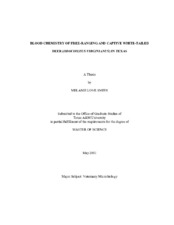| dc.description.abstract | Blood samples were collected from 602 white-tailed deer (WTD) (Odocoileus virginianus) between October 2008 – October 2009, from 15 different counties throughout Texas. White-tailed deer were evaluated for serum biochemical parameters (total protein, albumin, calcium serum, phosphorus, glucose, blood urea nitrogen, creatinine, total bilirubin, creatine kinase, aspartate aminotransferase, glutamic-oxaloacetic transaminase, globulins, albumins to globulins ratio, gamma-glutamyl transferase, and magnesium) and the following variables were recorded: age, gender, county of collection, season, capture method, and status based on captive or free-ranging. The 14 biochemical parameters were compared for WTD among age groups fawns (<12 months), yearlings (≥12 months - <24 months) and adults (≥24 months), gender, season (Spring, Summer, Fall and Winter), status (captive or free-ranging) and capture method (physical restraint, anesthetized using physical restraint method of drug administration, anesthetized using dart gun method of drug administration, drop-netted, net-gunned, or hunter harvested). The data collected for these parameters was used to establish normal ranges for a comprehensive metabolic panel (serum chemistry panel) for WTD in Texas. These reference ranges will be used for both captive and free-ranging WTD to improve diagnostic screening and disease monitoring.
Captive vs. free-ranging status was statistically significant in WTD for 7 of the 14 physiological parameters. Significant differences and trends were observed among the three age groups. Calcium and phosphorus had an inverse relationship with age, while glucose had a direct relationship with age. Gender was statistically significant for 7 of 14 parameters. Anesthetized WTD vs. non-anesthetized had the greatest impact on mean blood chemistry values. Values for total serum protein, albumin, calcium, phosphorus, and globulins were higher for non-anesthetized WTD. Glucose, BUN, and AST mean values for higher for anesthetized WTD. | en |


